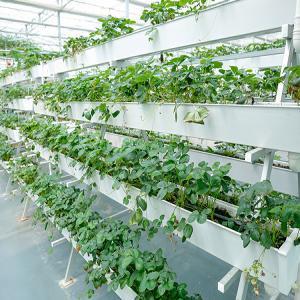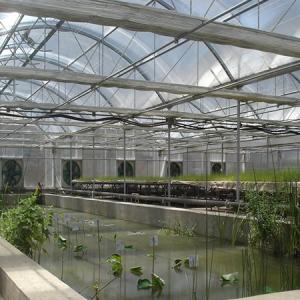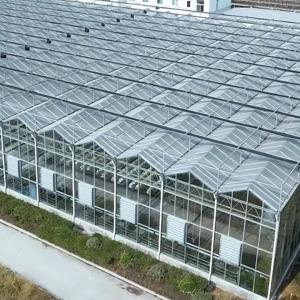Protection and Yield Preservation for Greenhouse Vegetables Amid Sudden Cold Waves
The passage of a cold wave is often accompanied by a "cliff-like" drop in temperature and a sharp increase in day-night temperature difference, posing a severe challenge to greenhouse vegetable production. At this point, both individual vegetable farmers and large-scale planting bases need to urgently activate cold protection emergency plans. They must not only build a solid "heat preservation defense line" to resist low-temperature attacks but also prepare "emergency treatment" measures to deal with sudden freezing damage. Only by making efforts in both aspects can losses be minimized and stable production and harvest of vegetables be ensured.
I. Multi-dimensional Temperature Increase and Heat Preservation: Building the First Line of Defense Against Cold
In a low-temperature environment, the core protection of greenhouses lies in reducing heat loss and quickly supplementing heat. A three-dimensional heat preservation system can be constructed through the combined method of "external insulation + internal protection + emergency heating".
For external protection, the top and surrounding areas of the greenhouse should be covered with thermal insulation quilts or straw mats, and an additional layer of plastic film should be laid on the outside. This measure can effectively prevent thermal insulation materials from absorbing moisture and getting damp during rainy and snowy weather, avoiding a significant reduction in thermal insulation performance. For areas prone to air leakage such as the surrounding areas, back walls, and shed feet of the greenhouse, multiple layers of straw mats or insulation curtains should be added to strengthen the windproof and thermal insulation effects. Buffer films should be installed at the ventilation openings and greenhouse doors, and a "thermal insulation air layer" should be formed through multi-layer coverage to reduce the direct inflow of cold air.
For internal temperature increase, simple small arch sheds can be built in the greenhouse for thermophilic vegetables, forming a double insulation structure of "shed within a shed". At the same time, sufficient auxiliary heating equipment such as electric heaters, automatic heating fans, air heating cables, electric hot-blast stoves, emergency heating fuel blocks, and oil-fired hot-blast stoves should be prepared in advance. These equipment should be activated in a timely manner according to the temperature changes in the shed when the cold wave hits, to ensure that the indoor temperature is stably maintained in the suitable growth range for crops.
II. Scientific Light Enhancement: Accumulating Cold-resistant Energy for Crops
In a low-temperature environment, sufficient light can not only directly increase the temperature of the shed but also enhance the photosynthesis of vegetables, accumulating nutrients needed by plants for cold resistance. Therefore, light management should be carried out through the dual measures of "cleaning for light transmission + active supplementary lighting".
Before the arrival of rainy and snowy weather, the fog droplets, dust, and debris on the surface of the greenhouse film should be cleaned in a timely manner to ensure the light transmittance of the film and avoid light obstruction. At the same time, combined with field management, the old leaves and diseased leaves at the lower part of the plants should be removed. This not only reduces nutrient consumption but also increases the ventilation and light transmittance between plants, allowing scattered light to evenly irradiate the middle and lower leaves.
For greenhouses with insufficient light, reflective curtains can be hung on the back walls of the greenhouses to enhance the light intensity inside the shed by using the principle of reflection. During consecutive rainy and snowy days, artificial supplementary lighting measures should be activated. Equipment such as plant growth lamps, LED supplementary lights, iodine-tungsten lamps, or sodium lamps can be used for supplementary lighting from 9 a.m. to 3 p.m. during the day, with 4-6 hours of supplementary lighting per day, to make up for the lack of natural light.
III. Strengthening Nutrient Management: Enhancing the Cold Resistance of Plants
The cold resistance of plants is closely related to their own nutrient reserves. Supplementing key nutrients through scientific fertilization can enhance cell activity and improve the ability of plants to resist low-temperature stress.
A sufficient amount of base fertilizer should be applied. On this basis, the proportion of phosphorus and potassium fertilizers should be appropriately increased, because phosphorus can promote root development, and potassium can enhance the water retention capacity of cells, reducing cell damage caused by low temperatures. At the same time, functional fertilizers such as amino acids, alginic acid, chitin, or humic acid should be applied in an appropriate amount. These substances can activate the stress-resistant genes in plants and improve their cold resistance.
One to two days before the arrival of the cold wave, foliar topdressing can be carried out by spraying compound biostimulants of amino acids and humic acid. Through the rapid absorption of leaves, the cold-resistant activity on the leaf surface can be enhanced, building a "nutritional protective layer" for plants and reducing the probability of freezing damage.
IV. Skillful Response to Sudden Clearing After Low Temperature: Avoiding Secondary Damage from "Seedling Sunscald"
Sunny weather often follows a cold wave, but the "sudden clearing" after low temperature is very likely to cause "seedling sunscald" damage to vegetables. This is because the air temperature in the shed rises rapidly, while the soil temperature rises slowly. At this time, the physiological function of the root system has not yet recovered, and its ability to absorb water and nutrients is weak. However, the transpiration of leaves increases sharply due to the rise in air temperature, which easily leads to insufficient water supply to the above-ground parts of the plants, resulting in phenomena such as leaf scorching and wilting.
The core of dealing with this situation lies in "slow temperature rise and gradual light exposure". The most effective method is to adopt the "curtain retraction" management: after sunrise in the morning, do not fully open the thermal insulation quilts or straw mats at one time, but first open one-third of them to allow the shed temperature to rise slowly. If straw mats are used for coverage, the method of "opening one every other mat" can be adopted to control the light intensity. For greenhouses with sunshade nets, the sunshade nets can be pulled up at noon when the temperature is relatively high to avoid direct exposure to strong light.
Generally, after 2-3 days of transitional management, when the plants gradually adapt, the thermal insulation quilts and sunshade nets can be opened normally. Under no circumstances should we rush, to prevent secondary damage caused by sudden changes in the environment.
V. Emergency Treatment for Freezing Damage: Precise Measures to Promote Recovery
Once plants suffer from chilling injury or freezing damage, scientific treatment measures must be taken immediately, focusing on "temperature and humidity control, nutrient supplementation, and disease prevention and control" to help plants recover as soon as possible.
In the early stage of freezing damage, the top priority is to stabilize the greenhouse environment. All air vents should be closed at night, and the night temperature should be appropriately increased by 2-3℃ to provide a warm recovery environment for the plants. During the day, the method of intermittent curtain opening should be adopted for shading to avoid a sharp rise in shed temperature, which would increase the respiratory consumption of plants and lead to dehydrating wilting. At the same time, flood irrigation with water and fertilizer is strictly prohibited to prevent the root system of frost-damaged plants from being stimulated by cold water and accelerating their death.
Nutrient supplementation should be carried out in a coordinated manner through "foliar application + root application". For foliar application, chelated amino acid-magnesium-calcium aqueous solution (amino acid content: 180g/L, calcium: 20g/L, magnesium: 10g/L) diluted 600 times can be sprayed, with a dosage of 30-45 liters per mu, and sprayed again at an interval of 5 days. High-activity amino acids can quickly repair damaged leaf cell tissues. Alternatively, foliar fertilizers containing sugars and amino acids, such as 25% glucose aqueous solution diluted 800-1000 times and 180g/L amino acid aqueous solution diluted 1000-1500 times, or plant growth regulators such as brassinolide, can be used to stimulate leaf expansion and stem node elongation. For root maintenance, humic acid or alginic acid fertilizers can be applied through drip irrigation, combined with phosphorus and potassium fertilizers such as potassium dihydrogen phosphate, to activate root activity and promote the growth of new roots and leaves.
In the later stage of freezing damage, plants have weak resistance and are prone to diseases, so it is necessary to do a good job in the "integrated water-fertilizer-pesticide-bacteria" prevention and control. 150ml of azoxystrobin suspension, 500ml of thiazole zinc suspension, and 500ml of amino acids can be applied per mu through drip irrigation. This can not only effectively prevent and control fungal and bacterial diseases but also supplement nutrients, improve the stress resistance of plants, and provide strong support for the healthy growth of plants.





